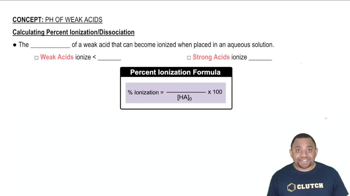Here are the essential concepts you must grasp in order to answer the question correctly.
Ionization of Acids
Ionization refers to the process by which an acid donates protons (H⁺ ions) to water, forming hydronium ions (H₃O⁺). Carbonic acid (H₂CO₃) undergoes two ionization steps, first losing one proton to form bicarbonate (HCO₃⁻), and then losing a second proton to form carbonate (CO₃²⁻). Understanding this process is crucial for writing the correct chemical equations.
Recommended video:
Calculating Percent Ionization of Weak Acids
Chemical Equilibrium
Chemical equilibrium occurs when the rates of the forward and reverse reactions are equal, resulting in constant concentrations of reactants and products. For the ionization of carbonic acid, the equilibrium expressions can be derived from the concentrations of the species involved in each step, reflecting the balance between the acid and its ions.
Recommended video:
Chemical Equilibrium Concepts
Equilibrium Expressions
Equilibrium expressions are mathematical representations of the concentrations of products and reactants at equilibrium, typically written in the form K = [products]/[reactants]. For carbonic acid, the equilibrium constants for its two ionization steps can be expressed as K₁ for the first ionization to bicarbonate and K₂ for the second ionization to carbonate, highlighting the relationship between the concentrations of the species involved.
Recommended video:
Equilibrium Constant Expressions
 Verified step by step guidance
Verified step by step guidance


